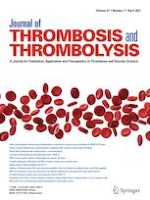Erschienen in:

18.03.2021
Decreased pulmonary artery distensibility as a marker for severity in acute pulmonary embolism patients undergoing ECG-gated CTPA
verfasst von:
Fei Yang, Dawei Wang, Shujun Cui, Yuexiang Zhu, Lan Liu, Mengmeng Ji, Dianjun Zou, Ru Zhao, Qingxiao Liu
Erschienen in:
Journal of Thrombosis and Thrombolysis
|
Ausgabe 3/2021
Einloggen, um Zugang zu erhalten
Abstract
To investigate the characteristics of pulmonary artery distensibility (PAD) in patients with acute pulmonary embolism (APE) and to assess whether a relationship exists between PAD and the disease severity. Clinical and radiological data of 30 APE patients who underwent retrospective electrocardiogram (ECG)-gated computed tomography pulmonary angiography (CTPA) with a definite diagnosis of APE were retrospectively reviewed in the present study, including 15 subjects in severe (SPE) group and 15 subjects in non-severe (NSPE) group. PAD and cardiac function parameters were compared between the two groups, their relationships were investigated, and receiver operating characteristic (ROC) curves were used to determine the sensitivity and specificity of the above parameters for the diagnosis of APE severity. The PAD decreased in the following order: NSPE group (6.065 ± 2.114) × 10−3 (%/mmHg), and SPE group (4.334 ± 1.777) × 10−3 (%/mmHg) (P < 0.05). All the cardiac function parameters except RA/LAdiameter showed statistically significant different values between the two groups (P < 0.05). As APE severity increased, the cardiac morphological measurements of RV/LVdiameter, RV/LVarea, RVEDV/LVEDV and RVESV/LVESV increased. There was a weak to moderate negative correlation between PAD and PAmax, PAmin, PA/AAmin, PA/AAmax, RV/LVdiameter, RV/LVarea (r = −0.393 to −0.625), that is, PAD was inversely correlated with cardiac function parameters. There was a moderate negative correlation between PAD and hemoptysis(r = −0.672). The area under the ROC curve (AUC) of PAD was 0.724, the critical value was 4.137 × 10−3 mm/Hg, and the sensitivity and specificity were 60.0% and 93.3%, respectively. PAmin showed the strongest discriminatory power to identify high-risk patients (AUC = 0.827), with the highest sensitivity of 100%, which was also achieved by RA/LAarea. The PAD obtained by retrospective ECG-gated CTPA could be an indicator to be used in the evaluation of the presence and severity of APE.